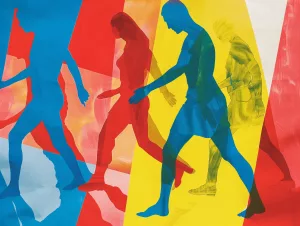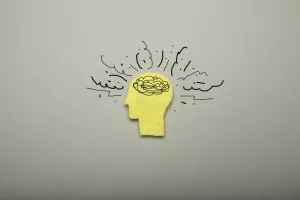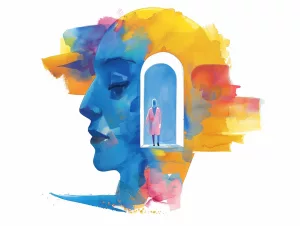Table of Contents
Introduction to Technological Influences on Behavior
The digital age has ushered in a transformative era, markedly reshaping how we communicate, think, and behave. This profound impact of technology on human behavior is not unprecedented; history is replete with moments where technological advancements significantly altered societal norms and individual behaviors. For instance, the introduction of the printing press in the 15th century democratized information and spurred the Renaissance, much as the internet today has revolutionized access to knowledge and global communication.
Today, digital technologies—especially social media, artificial intelligence (AI), and mobile computing—are at the forefront of contemporary behavioral changes. These tools not only influence how we interact with the world and each other but also raise concerns and fears about their pervasive role in our lives. Like the television revolution of the 20th century, which changed leisure patterns and family dynamics, today’s digital transformation is redefining social interactions, personal identity, and even our mental health.
In this section, we explore the specific ways in which modern technology influences behavior. From the impact of social media on our social and emotional lives to the potential for AI to alter decision-making processes and the growing concern over digital addiction, we delve into the nuances of how technology continues to mold human behavior in the digital era. Each of these aspects offers a window into the complex interplay between technology and human actions, reflecting broader shifts in how we perceive and engage with the world around us.
Social Media and Digital Communication
Social media and digital communication technologies have fundamentally altered the landscape of human interaction. These platforms not only facilitate unprecedented levels of connectivity but also reshape our social behaviors, influence our self-identity, and impact public discourse.
Influence on Social Behaviors
Social media platforms like Facebook, Instagram, and Twitter have transformed traditional socialization processes, allowing people to maintain larger social networks and interact with others across vast distances. Research indicates that these platforms can strengthen social ties and provide valuable support networks, especially for individuals who might otherwise feel isolated [1]. However, they also pose challenges, such as the risk of superficial connections and the pressure to curate a perfect online persona, which can lead to feelings of inadequacy and anxiety [2].
Impact on Self-Identity and Self-Esteem
Digital communication tools also play a significant role in shaping users’ self-identity and self-esteem. The constant exposure to idealized images and lifestyles can skew perceptions of normalcy and success. Studies have shown that prolonged use of social media can negatively affect self-esteem, particularly among teenagers and young adults, by promoting unhealthy comparisons and unrealistic expectations [3]. On the positive side, these platforms can also offer spaces for self-expression and identity exploration, particularly valuable for marginalized groups seeking community and recognition [4].
Effects on Public Discourse
The role of social media in public discourse is profound and double-edged. It democratizes information dissemination, allowing anyone to share news and opinions widely, which can amplify marginalized voices and facilitate movements for social change. However, it also complicates the information landscape, contributing to the spread of misinformation and polarization. The algorithms that curate and present content on these platforms often promote sensational and divisive content to maximize user engagement, potentially distorting public discourse and exacerbating social divides [5].
Conclusion
Social media and digital communication tools have deeply integrated into modern life, influencing how we connect, how we see ourselves, and how we interact with the world. While they offer numerous benefits by enhancing connectivity and providing platforms for self-expression and activism, they also pose significant challenges by affecting mental health and shaping public discourse. Navigating this landscape requires a balanced understanding of both the opportunities and risks presented by digital technologies.
Artificial Intelligence and Behavior
Artificial Intelligence (AI) is reshaping human behavior by altering decision-making processes, transforming job roles, and even influencing social norms. As AI technologies integrate deeper into various aspects of life, they not only offer new opportunities but also present complex challenges, particularly concerning ethics and societal impacts.
AI in Decision-Making
AI systems are increasingly used to support or make decisions in areas ranging from healthcare diagnostics to financial services. These systems can process vast amounts of data faster and more accurately than humans, potentially improving decision outcomes. However, the reliance on AI also raises questions about the transparency of decision-making processes and the biases that may be inherent in AI algorithms. Studies have highlighted the risk of perpetuating existing biases through AI unless these systems are carefully designed and continually monitored [6].
Transformation of Job Roles
AI is also transforming job roles across industries. Automation and AI tools can take over routine and repetitive tasks, freeing human workers to engage in more complex and creative activities. This shift has the potential to enhance job satisfaction and productivity but also requires significant adjustments in workforce skills and job training programs. The displacement of jobs by AI poses a significant challenge, necessitating policies and training programs that help workers transition to new roles where human skills are irreplaceable [7].
Influence on Social Norms
As AI becomes more embedded in everyday life, it also influences social norms and interactions. For instance, virtual assistants and chatbots are changing how people seek information and interact with technology, creating new norms around communication and convenience. Additionally, AI-driven personalization in media consumption is shaping cultural experiences by influencing what news, entertainment, and information we are exposed to, potentially creating echo chambers that reinforce specific views and behaviors [8].
Ethical and Societal Implications
The rise of AI prompts serious ethical considerations, particularly regarding privacy, surveillance, and autonomy. The deployment of AI in surveillance technologies can lead to enhanced security measures but also raises concerns about privacy rights and the potential for mass surveillance. Ensuring that AI technologies respect human rights and ethical standards is critical as their influence grows [9].
Conclusion
AI’s impact on behavior is profound and multifaceted, offering both significant benefits and notable challenges. As we navigate this evolving landscape, a balanced approach is essential—one that harnesses AI’s potential to improve human life while vigilantly addressing the ethical and social challenges it poses.
Digital Addiction
Digital addiction is becoming increasingly recognized as a significant behavioral issue, characterized by compulsive use of digital devices such as smartphones, tablets, and computers. The condition can lead to detrimental effects on mental health, social relationships, and daily functioning.
Characteristics and Impact
Digital addiction involves persistent and recurrent use of digital media, often to an extent that it impairs personal, family, social, educational, occupational, or other important areas of functioning. Symptoms can include a preoccupation with digital media, withdrawal symptoms when not using digital devices, a need to spend increasing amounts of time on these activities, and unsuccessful attempts to quit or control device use. The impacts are wide-ranging, potentially affecting mental health by increasing stress, depression, and anxiety, as well as causing physical issues like eye strain and sleep disturbance [10].
Psychological Mechanisms
The addictive nature of digital technologies can be attributed to their ability to provide immediate rewards or reinforcements, such as social approval through likes and shares, which trigger the release of dopamine, a neurotransmitter associated with reward and pleasure pathways in the brain. This mechanism can encourage repeated behaviors and foster a psychological dependency similar to that observed in gambling addiction [11].
Vulnerable Populations
Certain populations, including adolescents and young adults, are particularly susceptible to digital addiction due to their high usage rates and the developmental sensitivity of their social and reward systems. The integration of digital devices into all aspects of life, including education and social interaction, makes it challenging to mitigate the risks associated with their overuse [12].
Management and Prevention
Addressing digital addiction requires a multifaceted approach that includes psychological interventions, educational programs, and policy-level actions. Cognitive-behavioral therapy (CBT) has shown effectiveness in treating various forms of addiction and can be adapted for digital addiction by helping individuals develop healthier usage habits and coping strategies. Furthermore, preventive measures, such as promoting digital literacy and healthy technology use habits from a young age, are crucial in managing this growing issue [13].
Conclusion
Digital addiction represents a modern challenge that parallels the rise of digital technology use. Understanding its psychological impacts and implementing effective management strategies are essential for mitigating its effects on individuals and society. As digital landscapes continue to evolve, ongoing research and adapted interventions will be vital in addressing the complexities of digital addiction.
Conclusion
The influence of technology on human behavior is profound and pervasive, shaping how we interact, think, and feel in our daily lives. From the way social media redefines our social interactions and self-perception to how artificial intelligence impacts our decision-making and job functions, technology is deeply intertwined with modern behavior patterns. Moreover, the growing concern over digital addiction highlights the potential downsides of our increasingly connected world.
As we continue to advance technologically, it becomes crucial to understand and address these behavioral changes. By fostering awareness and developing strategies to mitigate the negative impacts while enhancing the positive, we can better navigate the complexities of this digital era. Embracing the opportunities technology offers, while remaining vigilant about its challenges, will be key to ensuring that our technological progress enhances rather than detracts from our quality of life.
Read more
Exploring Human Behavior: Why do We All React in Different Ways?
Understanding Human Behavior – A Physiological Approach
Human Behavior Research: The Complete Guide
References
- Ellison, N. B., Steinfield, C., & Lampe, C. (2007). “The Benefits of Facebook ‘Friends:’ Social Capital and College Students’ Use of Online Social Network Sites.” Journal of Computer-Mediated Communication. ↩
- Chou, H. T. G., & Edge, N. (2012). “‘They Are Happier and Having Better Lives than I Am’: The Impact of Using Facebook on Perceptions of Others’ Lives.” Cyberpsychology, Behavior, and Social Networking. ↩
- Vogel, E. A., Rose, J. P., Roberts, L. R., & Eckles, K. (2014). “Social Comparison, Social Media, and Self-Esteem.” Psychology of Popular Media Culture. ↩
- Duguay, S. (2016). “‘He Has a Way Gayer Facebook Than I Do’: Investigating Sexual Identity Disclosure and Context Collapse on a Social Networking Site.” New Media & Society. ↩
- Allcott, H., & Gentzkow, M. (2017). “Social Media and Fake News in the 2016 Election.” Journal of Economic Perspectives. ↩
- Angwin, J., Larson, J., Mattu, S., & Kirchner, L. (2016). “Machine Bias.” ProPublica. ↩
- Manyika, J., Chui, M., Miremadi, M., Bughin, J., George, K., Willmott, P., & Dewhurst, M. (2017). “A Future That Works: Automation, Employment, and Productivity.” McKinsey Global Institute. ↩
- Pariser, E. (2011). “The Filter Bubble: What the Internet Is Hiding from You.” Penguin Press. ↩
- Crawford, K., & Calo, R. (2016). “There is a blind spot in AI research.” Nature. ↩
- Young, K. S. (1998). “Internet Addiction: The Emergence of a New Clinical Disorder.” CyberPsychology & Behavior. ↩
- Volkow, N. D., Koob, G. F., & McLellan, A. T. (2016). “Neurobiologic Advances from the Brain Disease Model of Addiction.” The New England Journal of Medicine. ↩
- Lin, L. Y., Sidani, J. E., Shensa, A., Radovic, A., Miller, E., Colditz, J. B., Hoffman, B. L., Giles, L. M., & Primack, B. A. (2016). “Association Between Social Media Use and Depression Among U.S. Young Adults.” Depression and Anxiety. ↩
- Winkler, A., Dörsing, B., Rief, W., Shen, Y., & Glombiewski, J. A. (2013). “Treatment of Internet Addiction: A Meta-Analysis.” Clinical Psychology Review. ↩











